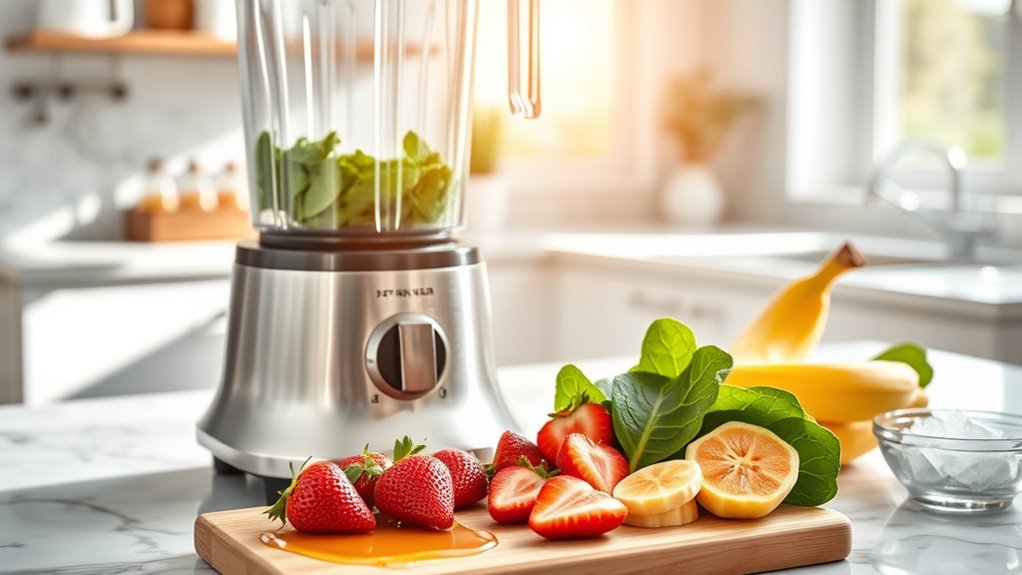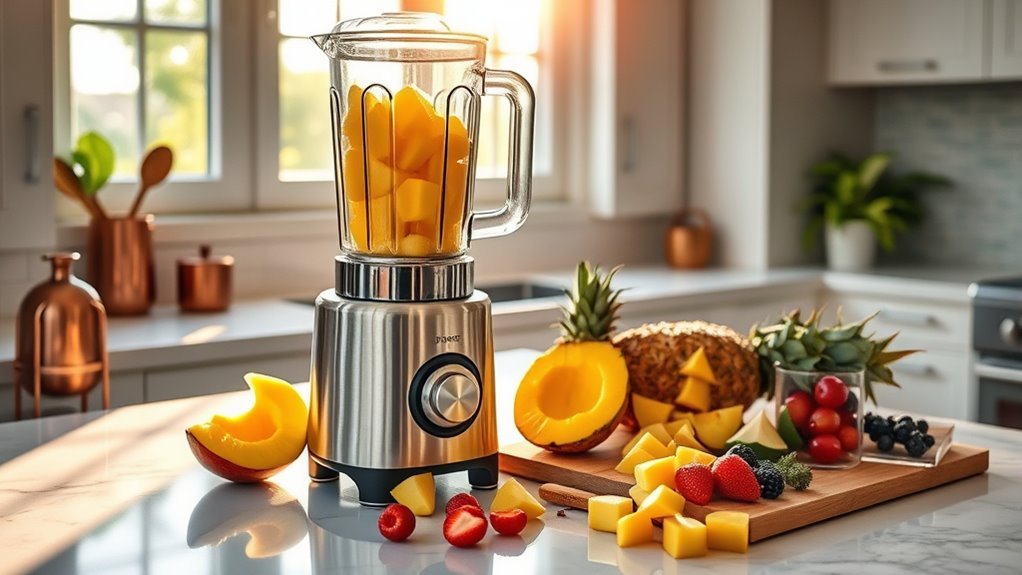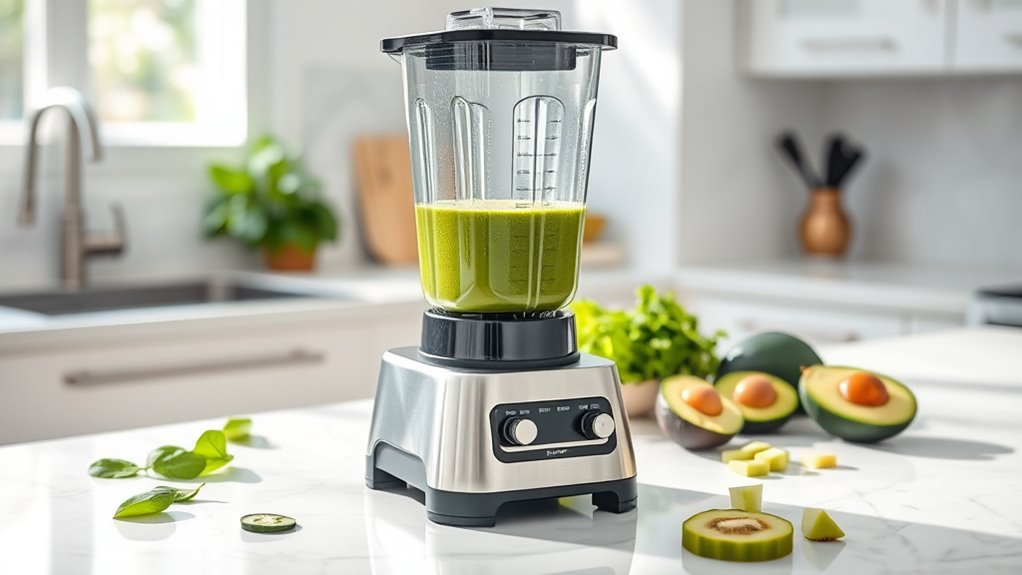We’ve all been there—pulverizing ice only to have our blender give up after a year. Pathetic. When it comes to durability, Vitamix crushes the competition, dominating Consumer Reports with four of the top five spots. Their ten-year warranties aren’t just talk. Meanwhile, Ninja commands 44% market share with 92% of their 2013-2021 models still crushing it. But is paying premium prices worth the extra years? The answer might surprise you.
Top-Rated Brands for Long-Term Performance

The blender world isn’t complicated. Some brands last, others fail. Period.
When it comes to durable blender brands, Vitamix dominates the scene.
Their 5200 model and others claim four of the top five positions in Consumer Reports ratings.
Seven-year warranty. Serious commitment to quality.
Ninja isn’t far behind, commanding an impressive 44% market share.
Their high-powered blender models work well year after year, with 92% still crushing ice and fruit years later. That’s reliability you can count on.
Don’t overlook NutriBullet for personal blenders—34% market share and equally impressive longevity stats. Cleanblend deserves mention too, with warranties that embarrass the competition.
Our tests of full-sized blenders consistently show Vitamix and Ninja leading the pack.
Strong motors, thoughtful design, and improving reliability since 2021.
High-performance blenders offer better nutrient extraction due to their powerful motors that break down tough ingredients more effectively.
Some things in life are simple: these brands last.
Warranty Coverage Comparison Among Leading Manufacturers
When it comes to warranties, you’re really buying peace of mind—and some manufacturers offer a lot more peace than others.
Vitamix models dominate with impressive 7 to 10-year warranties.
Their best model, the A3500, gets a full decade of coverage!
Compare that to KitchenAid’s K150 3 Speed Ice blender, which comes with a measly 1-year warranty.
Seriously, just one year?
In the models we tested, Oster’s Versa Pro holds its own with a solid 7-year guarantee, while Cleanblend starts at 5 years.
Sure, you can extend it to 10 years for $75, but that’s still extra cash on top.
The expensive Vitamix blenders we’ve tested consistently earn high reliability ratings.
The Power Blender actually backs up its premium price with four-and-a-half years more warranty than cheaper competitors.
With proper maintenance, these high-performance blenders can last well beyond their warranty periods, with statistics showing less than 2% return for service under warranty.
Durability Factors That Determine Blender Lifespan

Every blender has a breaking point—some just take years longer to reach it. We’ve seen the Vitamix 5200 still crushing ice like a champ after four years of daily abuse. Why? Quality components matter. Period.
High-grade stainless steel blades and powerful motors aren’t just marketing fluff—they’re why 92% of blenders purchased between 2013 and 2021 still work.
The tapered jar design isn’t merely pretty; it creates an efficient vortex that reduces motor strain.
Materials tell the truth too. Glass jars handle hot ingredients better but can crack.
Our test kitchens prove blender features like the Cleanblend’s robust design make it genuinely easy to clean and maintain.
The warranty tells all—Vitamix’s seven-to-ten-year coverage isn’t generosity. It’s confidence backed by data.
Consumer Reports: Real-World Longevity Testing Results
Real numbers don’t lie—and Consumer Reports’ exhaustive surveys have them in spades.
Their data on 33,437 blenders from over 30,000 members tells a compelling story: 92 percent of blenders purchased between 2013 and 2021 were still in use.
That’s impressive longevity.
Full-sized blenders dominate the market at 79 percent of units analyzed, and reliability ratings are trending up.
Most brands now score excellent or very good.
Finally.
Vitamix crushes the competition, claiming four of the top five spots in Consumer Reports’ rankings.
The Vitamix Ascent X series particularly shines when measuring both reliability and owner satisfaction.
The average blender should serve you well for about eight years.
Not bad.
Durability has improved across the board, with consumer feedback confirming what we’ve suspected all along—you get what you pay for.
Cost vs. Durability: Finding the Best Value in Blenders

The price tag of a blender often hides an uncomfortable truth: cheap now means expensive later.
When comparing kitchen appliances across the price range, the math gets interesting.
Sure, that cheaper blender like the KitchenAid K150 at $160 seems tempting, but its measly one-year warranty tells you everything.
Meanwhile, the Cleanblend at $170 offers ten years of coverage. That’s not a typo.
Mid-range blenders like the Oster Versa ($280-$350) sound reasonable until they burn out after just 2-3 years. Not exactly the best budget option anymore, is it?
The pricey Vitamix 5200 ($500) keeps blending for ages with variable speeds and preset programs that are actually easy to use. Eight years later, while others shop for replacements, your blender delivers. Still.
Frequently Asked Questions
What Is the Most Durable Blender?
We’ve found Vitamix 5200 is the most durable blender. Its powerful motor, stable base, heat-resistant jar, balanced weight, sharp blades, quality seals, simple control panel, and aesthetic design guarantee long-lasting performance.
Which Blender Has the Longest Warranty?
Based on our warranty comparisons, the Vitamix A3500 offers the longest manufacturer assurance at 10 years. Cleanblend’s protection plan can match this with their extended coverage option for an additional $75.
What Blender Has the Longest Life?
Like trusty kitchen warriors, Vitamix blenders outlast competitors. We’ve found they survive longest through frequent usage, proper cleaning methods, and available replacement parts—often functioning well beyond their impressive seven-year warranty according to user reviews.
How Long Should a Blender Last?
We expect a quality blender to last about eight years, though proper maintenance, gentle cleaning routines, and storage methods greatly impact longevity. Daily usage frequency affects motor health, blade durability, and potential overuse effects.

